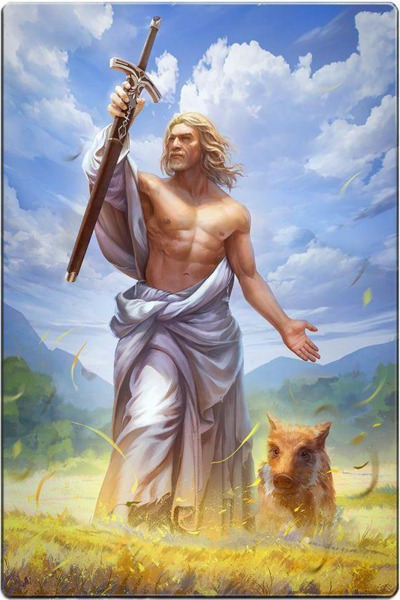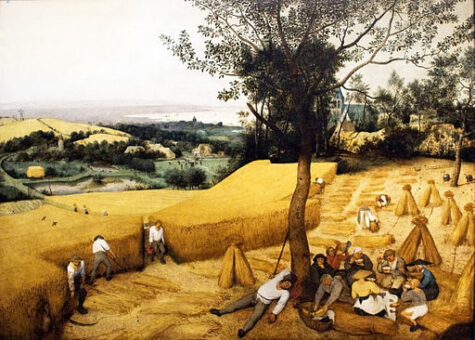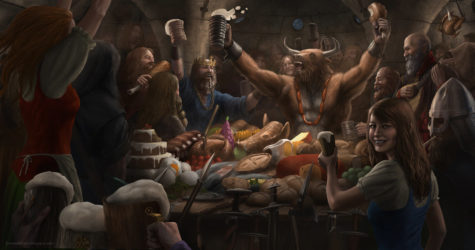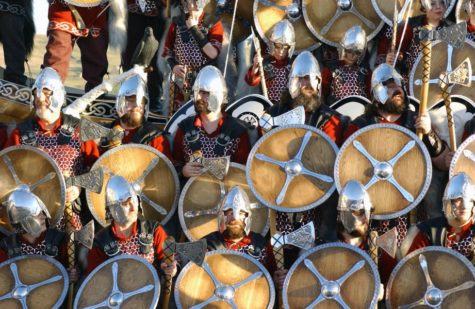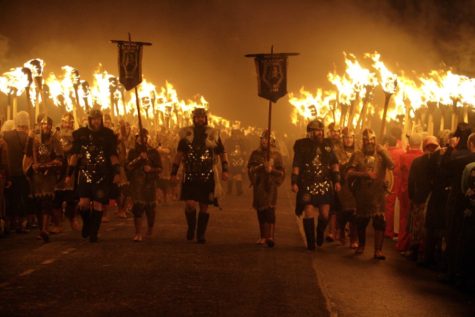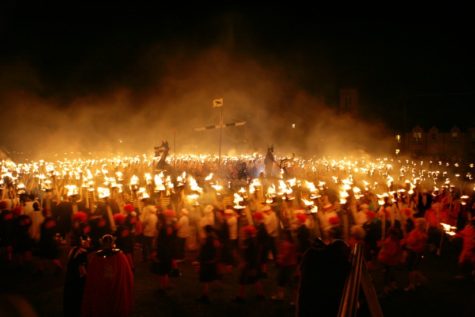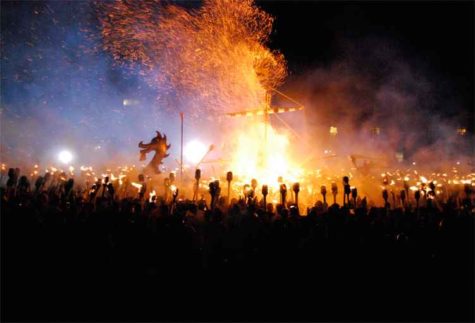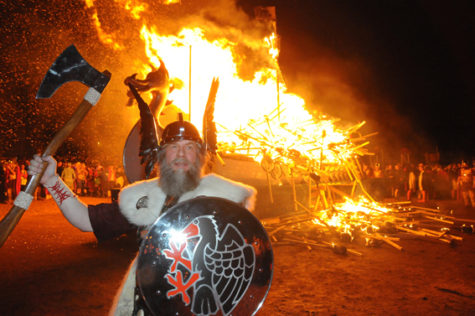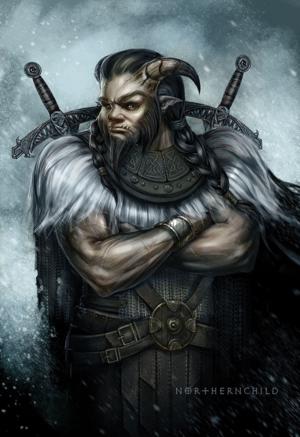Viking
Freyfaxi, Freysblöt, or Hlæfæst (which means Loaf Feast) which celebrates the beginning of the harvest. There is no specific “correct” date for this harvest festival; some groups celebrate it at the beginning of the month (to coincide with Lammas), some mid-month, and some on the full moon.
Freyr is the Norse god of fertility and harvest and a blöt is a sacrifice or offering to a god. So Freysblöt is offerings to Freyr, this is done in celebration of the beginning of harvest. The feast is also thought of as holy to Thor as a harvest God and his wife Sif, whose long golden hair can be seen in fields of ripe grain.
The first sheaf of harvested grain was bound and blessed for the gods and the vaettir (land or place spirits). Bread baked from the first harvest was also made into an offering and shared with the community.
In Viking times this is also when the warriors who had gone off to fight at the end of planting season came back, loaded with a summer’s worth of plunder and ready to reap the crops that had ripened while they were gone. It is almost like American thanksgiving, feasting and celebrating the first fruits and grains from harvest.
In modern times this is often just before back-to-school giving families and kindreds a good opportunity to celebrate together before the added stresses of homework and extracurricular activities. While the celebrations were modest compared to some of the other major holidays it was still an excellent reason to gather in celebration and to recognize the prosperity in our lives.
Since it draws from First Harvest traditions, the dates would vary regionally, but falls sometime in the beginning of August, because that is when many of our gardens are coming into full production. Typically in the northern hemisphere it is around this time that we celebrate the bounty of the Earth, and the gifts that she brings us with the help of Frey.
In truth, “Freyfaxi” is basically made up and can be celebrated by any group that wants to when they want to. It isn’t wholly without reference, as it draws on a history of First Harvest traditions, but it isn’t historical by any means. Wikipedia pins it on August 1st, the Ásatrú Alliance’s holidays page dates it as August 19th, and many Pagan Calendars date it to August 23rd.
Loaf-Feast is the end of the summer’s vacation, the beginning of a time of hard work which lasts through the next two or three months, while we ready ourselves for the winter.
The holiday of FreyFaxi was much more important for the lives of our ancestors that it is today. Without a good harvest, many many people would perish in the winter. We honor Frey to thank him for the many harvests that we have had, if there was one terrible one, some of us may not be here today. Thanks to Frey we are. If a year was particularly horrible, drastic sacrifice would be used – animal, or even human in some cases.
Even though many of us are no longer farmers, we still depend on the land for all that we are given. Maybe we do not depend on it directly but most of us go to the grocery store and buy things that have come from the fields. This is a time to honor Frey, god of the harvest, rains, and fertility. A time to thank him for the bounty of the earth, and all the gifts that he bestows upon us.
Today we honor him with mead, or some type of drink, food from our table, typically foods we harvest ourselves, for example baked bread that we have made ourselves from the wheat he has bestowed upon us. It is traditional to mark the holiday by baking a figure of the God Freyr in bread, and then symbolically sacrificing and eating it. Any way that you honor Frey, is a good way. Traditionally however, it is with a blot and feast.
We honor him because without him, simply we would not have much of our food supply, and quite obviously without that, we do not have much at all! He bestows fertility to the fields and plants, gives them life, giving rain so that they may grow and flourish. These plants including trees, give us oxygen. So if you are not going to honor Frey, son of Njord, for the bounty of the land at least honor him for the life of the plants and world around us!
We honor Frey by giving him a blot, and a grand feast from our own gardens and the fields. (If you do not have these things at least go spend some money and get a few things from a farmers market or something similar). We thank Frey, and honor him for the harvest and the fertility of the land and ask him to give the land even greater fertility in the coming year and in the dark of winter.
Sources:
January 9th is a day of remembrance for Raud the Strong. Here’s his story:
When Raud refused to give up Asatru (Icelandic for “Æsir”), King Olaf Tryggvason of Norway executed him by making him swallow a snake. His land and all his wealth was then confiscated.
Praise Raud the Strong by lifting a horn (or cup or glass) in his honor, and by doing something deliberate to spread the religion King Olaf tried so hard to stamp out. Alternatively, you might want to hold a Sumbel, a drinking-ritual in which a drinking horn full of mead or ale is passed around and a series of toasts are made, usually to gods, ancestors, and/or heroes of the religion.
The toasts vary by group, and some groups make a distinction between a “regular” sumbel and a “high” sumbel, which have different levels of formality, and different rules during toasting. Participants may also make boasts of their own deeds, or oaths or promises of future actions. Words spoken during the sumbel are considered carefully and any oaths made are considered sacrosanct, becoming part of the destiny of those assembled.
Up Helly Aa refers to any of a variety of fire festivals held in Shetland, in Scotland, annually in the middle of winter to mark the end of the yule season and celebrate the arrival of the Vikings. Traditionally held on the last Tuesday in January, the festival involves a procession of up to a thousand guizers in Lerwick and considerably lower numbers in the more rural festivals, formed into squads who march through the town or village in a variety of themed costumes.
The current Lerwick celebration grew out of the older yule tradition of tar barreling which took place at Christmas and New Year as well as Up Helly-Aa. After the abolition of tar barreling, permission was eventually obtained for torch processions. The first yule torch procession took place in 1876. The first torch celebration on Up Helly-Aa day took place in 1881. The following year the torch lit procession was significantly enhanced and institutionalized through a request by a Lerwick civic body to hold another Up Helly-Aa torch procession for the visit of the Duke of Edinburgh. The first galley was burned in 1889.
There is a main guizer who is dubbed the “Jarl”. There is a committee which you must be part of for fifteen years before you can be a jarl, and only one person is elected to this committee each year.
The procession culminates in the torches being thrown into a replica Viking longship or galley. The event happens all over Shetland, but it is only the Lerwick galley which is not sent seaward. Everywhere else, the galley is sent seabound, in an echo of legendary Viking sea burials.
After the procession, the squads visit local halls (including schools, sports facilities and hotels), where private parties are held. At each hall, each squad performs its act, which may be a send-up of a popular TV show or film, a skit on local events, or singing or dancing, usually in flamboyant costume.
Due to the often-flamboyant costumes and the large quantity of males dressing up as females (Traditionally, the Capital festival does not permit women to partake in the squads) in the Lerwick festival, it has earned the joke name ‘Transvestite Tuesday’. The photos below show a few examples of the festival’s highlights.
Source: Wikipedia
Official Website: Up Helly Aa
July 29, is the festival of the Anglo-Saxon god Thunor and the Norse god Thor, a time of ascendant power and order. The great thunder-God Thor was honored on this date with prayers for protection of the crops against destructive storms in the older times in Europe.
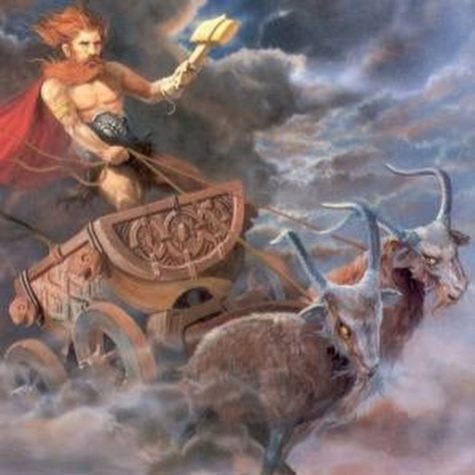
Prayer to Thor for Strength
by Seawalker
Thunder rolls, lightning strikes,
And the hammer flies across the sky.
God of the weather, chariot of the storm,
Master of rain and torrents,
Son of the strength of Mother Earth,
I ask you to grant me that strength for myself.
You who are so great that you cannot walk
Across the Rainbow Bridge without breaking it,
You whose tree is the mighty oak,
O Thunor, grant me that unending sturdiness.
Let me not break beneath the blows of misfortune.
Keep me from being crushed when the powerful
Stomp their large feet on the smaller ones below.
You who are the guardian of the common man,
You who care for the farmers and workers,
Look upon me here in this place where I am
Only one of many, and protect my steps.
Make me resilient and mighty as your own arm,
Make me unbreakable, you who are Friend of Man.
I ask for one small percentage of the vigor
Of the right arm of the Thunderer,
That I might brave the tempest
And stand firm in the gales.
Thunder rolls, lightning strikes,
And the hammer flies across the sky.
Found at Thor’s Shrine
June 14 is sacred to the Viking god Vidar. He is one of the sons of Odin and destined to survive Ragnarok and rule over the earth afterwards. He is the personification of the vital energy of nature which returns greening the land even after major disasters.
He is the patron of leather workers. According to Viking tradition, leather workers would put aside all of their off-cuts. These scraps of leather would be buried as offerings to Vidar, and to remove bad luck and evil vibes from the giver.
Vidar gathers these leather scraps to make his enormous, tough leather boot, and at the end of time he will stop Ragnarok when he kills the Fenris wolf by booting it in the mouth.
Later, Christianity changed Vidar to St. Vitus.
Source: Raven Corbis
